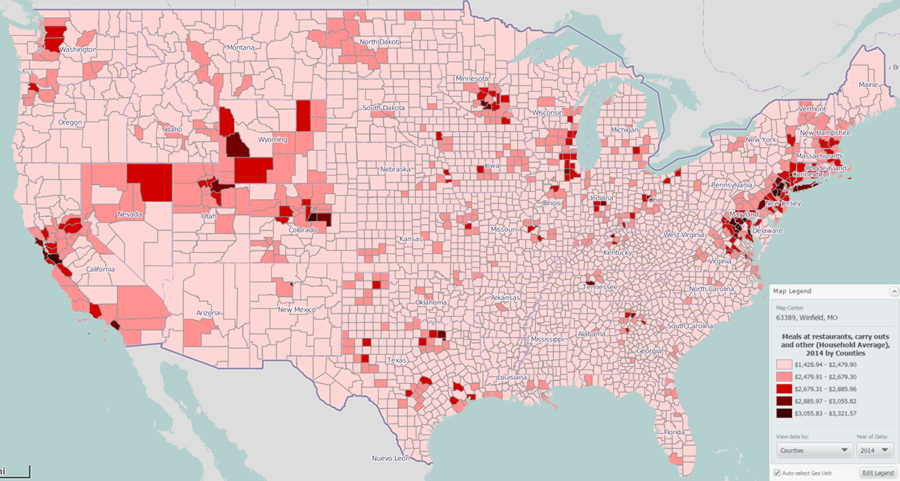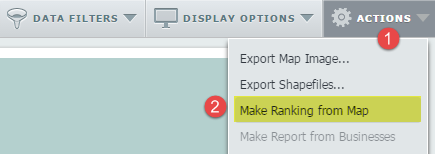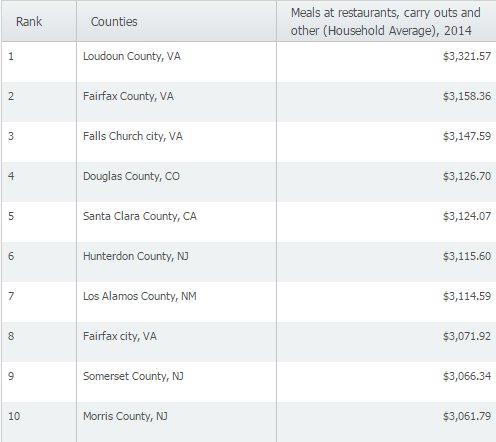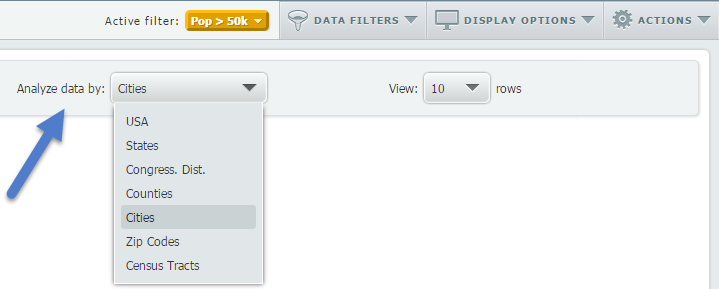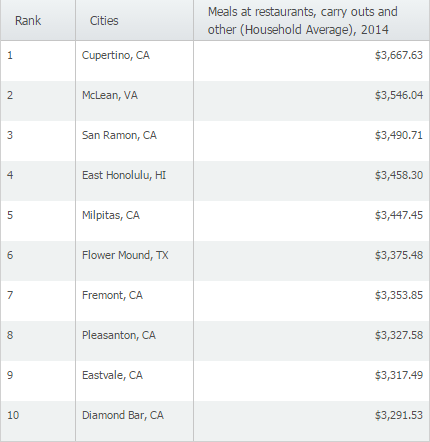Exploring SimplyMap Data: Which US Locations Dine Out the Most?
With over 75,000 variables in SimplyMap, you can find virtually any information you want. This week, we take a look at which U.S. locations spend the most money eating at restaurants or carrying out. Here’s how we did it and what we found.
The variable used was, “Meals at restaurants, carry outs and other (Household Average), 2014.” This variable can be found using this path in SimplyMap: Consumer Expenditure » In 2010 Geographies » Food » Food Away from Home » At Restaurants, Carry-Out, Etc.
Before we rank other geographies, let’s view the nation at large.
This provides a great overview, and we can see that a number of counties, mostly focused in the Northeast and West, lead the way for average household spending on dining out. We can analyze the data further by ranking these counties, using the “Make Ranking from Map” feature, which can be accessed from the Actions menu near the upper right corner of the Map panel.
Selecting, “Make Ranking from Map” yielded the following top 10 counties:
It looks like Loudoun County, VA spends the most amount of money dining out at restaurants in the United States.
Next, we wanted to view the same variable by city. Use the Analyze data by: menu at the top of the report to change the geographic unit to cities (note that you can also choose States, Zip Codes, or even Census Tracts if you want information about a specific local area).
When we switched to city, and applied a data filter to only show cities with more than 50,000 residents (read more about our data filter here), we were left with the following cities:
This information, combined with some additional research in SimplyMap, could be helpful in understanding dining habits in your study area, or even in siting a new business. SimplyMap combines analytical insight from reports like these with the visual impact of compelling maps in your research to help you understand, analyze, and visualize your data.
More from SimplyAnalytics
SimplyAnalytics at NCLA 2025 – Visit Us at Booth #225!
Posted on Sep 15, 2025 by Admin
SimplyAnalytics will be attending the upcoming NCLA Conference in Winston-Salem October 14-17!
SimplyAnalytics is Exhibiting at ALA Annual – Visit Us at Booth 2128!
Posted on Jun 05, 2025 by Admin
We’re excited to announce that SimplyAnalytics will be exhibiting at the American Library Association (ALA) Annual Conference in Philadelphia! We’re thrilled to showcase how SimplyAnalyti...
Visit SimplyAnalytics at the Charleston Library Conference – Nov. 12th
Posted on Oct 07, 2024 by Admin
We're headed to Charleston! Come visit the SimplyAnalytics team on November 12th at the Gaillard Center at booth 41. We'll be doing live demonstrations of the database, answering question...
2024 BRASS Student Travel Award Sponsored by SimplyAnalytics
Posted on Apr 30, 2024 by Admin
Congratulations to Brandyn Whitaker as the recipient of the 2024 BRASS Student Travel Award! Brandyn is a Library Services Associate in the Workforce and Economic Development department a...
Come See Us at ALA Annual! Booth #1916
Posted on Mar 11, 2024 by Admin
We're thrilled to announce that SimplyAnalytics will be exhibiting at the ALA Annual Conference in San Diego! We can't wait to connect with library professionals, share insights, and show...
SimplyAnalytics at PLA 2024 in April!
Posted on Feb 02, 2024 by Admin
We are excited to be back exhibiting at PLA this April in Columbus, OH. Join us at Booth #2631 to discover how SimplyAnalytics can help libraries understand their service area, assist sma...
SimplyAnalytics at SCELCapalooza 2024!
Posted on Jan 23, 2024 by Admin
We are excited to again make the trip to Los Angeles for SCELCapalooza 2024 hosted at Loyola Marymount University! Please drop by our table on Wednesday, Feb. 28th to learn more about Sim...
SimplyAnalytics Proudly Sponsors the Midwest Entrepreneurship Case Competition
Posted on Jan 10, 2024 by Admin
We are delighted to announce our sponsorship of the Midwest Entrepreneurship Case Competition! At SimplyAnalytics, we understand the power of data-driven decision-making in entrepreneursh...
Introducing Election Data
Posted on Dec 11, 2023 by Admin
Hello readers! We have some fantastic news to share. SimplyAnalytics is thrilled to announce the addition of 2020 Election data to our expanding collection of powerful datasets. With this...
Release Announcement
Posted on Nov 28, 2023 by Admin
Hello readers! We are happy to announce that SimplyAnalytics has successfully migrated to the Census 2020 boundaries on Sunday, November 19th. This blog will talk about what that is, what...
 Go up
Go up




